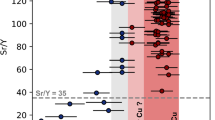Abstract
Accurate thematic classification is one of the most commonly desired outputs from remote sensing images. Recent research efforts to improve the reliability and accuracy of image classification have led to the introduction of the Support Vector Classification (SVC) scheme. SVC is a new generation of supervised learning method based on the principle of statistical learning theory, which is designed to decrease uncertainty in the model structure and the fitness of data. We have presented a comparative analysis of SVC with the Maximum Likelihood Classification (MLC) method, which is the most popular conventional supervised classification technique. SVC is an optimization technique in which the classification accuracy heavily relies on identifying the optimal parameters. Using a case study, we verify a method to obtain these optimal parameters such that SVC can be applied efficiently. We use multispectral and hyperspectral images to develop thematic classes of known lithologic units in order to compare the classification accuracy of both the methods. We have varied the training to testing data proportions to assess the relative robustness and the optimal training sample requirement of both the methods to achieve comparable levels of accuracy. The results of our study illustrated that SVC improved the classification accuracy, was robust and did not suffer from dimensionality issues such as the Hughes Effect.
Similar content being viewed by others
References
Barry P, Shippert P, Gorodetzky D, Beck R (2003) Draft Hyperion hyperspectral mapping exercise using atmospheric correction and end members from spectral libraries and regions of interest with data from Cuprite, Nevada. EO-1 User Guide, v 2.3, 74 p
Benediktsson JA, Sveinsson JR, Arnason K (1995) Classification and feature extraction of AVIRIS data. IEEE Trans Geosci Remote Sens 33(5):1194–1205
Chi M, Bruzzone L (2007) Classification of hyperspectral remote sensing data with primal semi-supervised SVMs: 4rth International Workshop on Pattern Recognition in Remote Sensing (PRRS’06), Hong Kong. IEEE Trans Geosci Remote Sens 45(6):1870–1880
Chang CI (2003) Hyperspectral imaging: techniques for spectral detection and classification. Kluwer/Plenum, New York, 370 p
Foody G, McCullagh MB, Yates WB (1995) The effect of training set size and composition on artificial neural net classification. Int J Remote Sens 16:1707–1723
Foody GM, Mathur A (2004) A relative evaluation of multiclass image classification by support vector machines. IEEE Trans Geosci Remote Sens 42:1335–1343
Gunn SR (1998) Support vector machines for classification and regression. Technical Report, University of Southampton, 54 p
Hord MR (1982) Digital image processing of remotely sensed data. Academic Press, New York, 256 p
Huang C, Davis LS, Townshed JRG (2002) An assessment of support vector machines for land cover classification. Int J Remote Sens 23:725–749
Hughes GF (1968) On the mean accuracy of statistical pattern recognizers. IEEE Trans Inf Theory 14:55–63
Hsu CW, Chang CC, Lin CJ (2003) A practical guide to support vector classification. National Taiwan University, 12 p
Ikeda M, Dobson FW (1995) Oceanographic applications of remote sensing. CRC Press, Boca Raton, 492 p
Jia X (1999) Adaptable class data representation for hyperspectral image classification. http://www.gisdevelopment.net/aars/acrs/1999/ts10/ts10109pf.htm
Keerthi SS, Lin CJ (2003) Asymptotic behaviors of support vector machines with Gaussian kernel. Neural Comput 15:1667–1689
Kohavi R, Provost F (1998) Glossary of terms. Mach Learn 30(23):271–274
Lillesand TM, Kiefer RW, Chipman JW (2004) Remote sensing and image interpretation, 5th edn. Wiley, New York, p 724
Melgani F, Bruzzone L (2004) Classification of hyperspectral remote sensing images with support vector machines. IEEE Trans Geosci Remote Sens, pp 1778–1790
Mertie JB Jr (1940) The Goodnews platinum deposits, Alaska. US Geol Surv Bull 918:97
Meyer D (2001) Support vector machines. R News, Volume 1/3. http://cran.r-project.org/doc/Rnews/Rnews_2001-3.pdf
Murai S (1996) GIS workbook (fundamental course). Japan Association of Surveyors, Tokyo, 169 p
Pal M, Mather PM (2005) Support vector machines for classification in remote sensing. Int J Remote Sens 26:1007–1011
Richards JA, Jia X (1998) Remote sensing digital image analysis, 3rd edn. Springer, Berlin, 63 p
Schrader S, Pouncey R (1997) Erdas field guide, 4th edn. Erdas Inc., Atlanta Georgia, 686 p
Schowengerdt RA (1983) Techniques for image processing and classification in remote sensing. Academic Press, New York, p 245
Sherrod PH (2003) Classification and regression trees and support vector machines for predictive modeling and forecasting. DTREG program manual. www.dtreg.com
Stewart JH, Carlson JE (1978) Geologic map of Nevada. Nevada Bureau of Mines and Geology, Map
Vapnik VN (1995) The nature of statistical learning theory. Springer, New York, 188 p
Zhu G, Blumberg DG (2002) Classification using ASTER data and SVM algorithms – The case study of Beer Sheva, Israel. Remote Sens Environ 80:233–240
Author information
Authors and Affiliations
Corresponding author
Rights and permissions
About this article
Cite this article
Oommen, T., Misra, D., Twarakavi, N.K.C. et al. An Objective Analysis of Support Vector Machine Based Classification for Remote Sensing. Math Geosci 40, 409–424 (2008). https://doi.org/10.1007/s11004-008-9156-6
Received:
Accepted:
Published:
Issue Date:
DOI: https://doi.org/10.1007/s11004-008-9156-6




